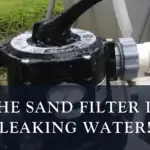You glance at your pool, a shimmering oasis of calm, only to discover an unexpected problem: your pool filter is leaking from the top. Panic sets in as you imagine the time, effort, and money needed to fix it.
But before you let stress take over, take a deep breath. You’re not alone in this, and fixing a leaking pool filter might be easier than you think. Imagine enjoying a carefree swim without the constant worry of water loss or equipment damage.
Understanding why your pool filter is leaking and how to resolve it can save you from unnecessary headaches. We’ll guide you through the common causes of leaks, how to identify them, and practical steps to get your pool back in perfect condition. Let’s get started on turning that leak into a story of success and peace of mind.

Credit: www.youtube.com
Identifying The Leak
Dealing with a pool filter leak can be frustrating. Understanding the issue is crucial before fixing it. Identifying the source of the leak is the first step. Leaks often occur at the top of the filter. Knowing what to look for makes the process easier.
Common Leak Signs
Water pooling around the filter is a clear sign. Another indicator is lower water pressure in the pool. Look for wet spots on the filter’s surface. Listen for hissing sounds near the filter. These sounds can suggest escaping air or water.
Tools Needed For Inspection
Gather simple tools for your inspection. You need a flashlight to spot leaks in dark areas. A towel is useful for drying surfaces and checking for new leaks. A small mirror helps see difficult spots. Keep a notepad handy to jot down observations.

Credit: www.reddit.com
Causes Of Top Leaks
Leaking pool filters can be frustrating. Understanding the causes is the first step to fixing the issue. Top leaks often occur due to specific problems. Identifying these can save time and prevent damage.
Damaged O-ring
The O-ring seals the filter’s top. If it is damaged, water escapes. This ring can wear out over time. Cracks or breaks in the ring are common causes. Regular checks help identify wear early.
Loose Clamp Or Lid
Loose clamps or lids cause leaks. They need to be tight to prevent water escaping. If they are not secure, leaks happen. Tightening them can often solve the problem. Make sure they are firmly in place.
Cracked Filter Housing
A cracked filter housing leads to leaks. The housing holds the filter in place. Cracks can develop from impact or pressure. Inspect the housing for any visible damage. Replacing a cracked housing may be necessary.
Quick Fixes For O-ring Issues
Leaking pool filters often have worn O-rings. Replace these rings to stop the leak. Ensure a snug fit to prevent future issues. Regular checks help maintain a leak-free system.
Dealing with a pool filter leak can be frustrating, especially when the water seems to be escaping from the top. A common culprit in this scenario is the O-ring, a small but vital component. Luckily, addressing O-ring issues can often be straightforward. Here are some quick fixes to get your pool filter back in action.Cleaning And Lubricating The O-ring
Dirt and debris can cause the O-ring to lose its seal, leading to leaks. First, turn off your pool filter system and release the pressure. Carefully remove the O-ring and clean it with a damp cloth. Use a non-petroleum-based lubricant to lightly coat the O-ring. This helps it maintain flexibility and ensures a tighter seal. A well-lubricated O-ring can often stop leaks without the need for a replacement. Have you ever cleaned an O-ring and noticed an immediate difference? It’s a simple yet effective approach. Regular maintenance can keep your pool filter running smoothly.Replacing A Worn-out O-ring
Sometimes, cleaning isn’t enough, and the O-ring is simply worn out. Cracks or a flattened shape indicate it’s time for a replacement. Purchase a new O-ring specifically designed for your filter model. When replacing, ensure the new O-ring is seated properly in its groove. A misaligned O-ring can cause just as many problems as a damaged one. This small investment in a new O-ring can save you from bigger headaches down the road. Have you checked your O-ring for wear and tear lately? Ignoring it can lead to more significant issues, but a quick replacement can extend the life of your pool filter.Securing Loose Clamps And Lids
Loose clamps and lids might cause pool filter leaks from the top. Tightening these can often stop the leak. Regular checks ensure a secure fit, preventing future issues.
Securing loose clamps and lids on your pool filter is crucial. This simple maintenance step can prevent leaks and improve efficiency. When these components are not tight, water may escape. This can lead to higher water bills and potential damage. By taking the time to address this issue, you can extend the life of your equipment. Let’s explore how to secure these parts effectively.Tightening The Clamp
Check the clamp that holds the filter lid. Make sure it is not loose. A loose clamp can cause leaks. Use a wrench or screwdriver to tighten it. Turn the tool until the clamp feels secure. Do not overtighten, as this can damage the clamp. Check the manufacturer’s instructions for guidance. Regularly inspect the clamp for wear and tear. Replace it if you notice any cracks or rust.Ensuring Proper Lid Alignment
Proper lid alignment is key to preventing leaks. Start by removing the lid and inspecting the seal. Clean any debris or dirt from the seal. This ensures a tight fit. Place the lid back on the filter. Align it carefully with the base. Ensure the lid fits snugly and evenly. An uneven lid can lead to leaks. Check for gaps around the lid. Adjust it if necessary to achieve a perfect fit. Regular checks can help maintain a leak-free system.Repairing Cracked Filter Housing
Experiencing a leak from the top of your pool filter often points to a cracked filter housing. Addressing this issue promptly ensures your pool remains clean and functional. Inspect the filter housing for visible cracks and consider professional repair or replacement to prevent further damage.
Dealing with a leaking pool filter can be a daunting task, especially when you discover the filter housing is cracked. This issue not only impacts the efficiency of your pool’s filtration system but can also lead to increased water bills and potential water damage. Understanding how to tackle this problem is crucial for maintaining your pool’s health and your peace of mind.Temporary Sealing Solutions
When you notice a crack in your filter housing, the first step is to assess the damage. Is it a small hairline crack or a more significant fracture? For minor cracks, temporary sealing solutions can buy you some time. Products like waterproof epoxy or silicone sealant can be applied directly to the crack. These materials are designed to withstand water pressure and can provide a quick fix. Always ensure the area is clean and dry before application for the best results. Have you ever tried a temporary fix only to realize it was more effective than expected?When To Consider Replacement
While temporary solutions can be effective, they aren’t meant to last forever. If the crack is extensive or if you’ve repaired it multiple times, it might be time to consider replacing the filter housing. Continually patching up the same spot can lead to bigger problems down the road, including more significant leaks or system failure. Replacement might seem costly upfront, but it could save you money in the long run. Have you ever regretted not investing in a permanent solution sooner? Remember, ensuring the integrity of your pool filter is crucial for a clean and safe swimming environment.Preventive Maintenance Tips
A leaking pool filter top often indicates worn gaskets or loose clamps. Regularly check for cracks and tighten parts. Cleaning and replacing seals can prevent water loss and costly repairs.
Your pool filter is a crucial part of keeping your pool clean and inviting. But what happens when you notice it’s leaking from the top? Preventive maintenance can save you from costly repairs and give you peace of mind. Let’s dive into some practical tips to keep your pool filter in top shape.Regular Inspection Routine
A regular inspection routine is your first line of defense. Make it a habit to check your pool filter every month. Look for any signs of wear, such as cracks or loose fittings. Do you notice any rust or corrosion? Address it immediately. Replace worn-out parts before they become a problem. Consider keeping a checklist. It helps you stay organized and ensures no part of the filter is overlooked. Wouldn’t it be great to avoid a mid-summer breakdown?Proper Storage During Off-season
When pool season ends, proper storage of your filter is vital. First, clean and dry it thoroughly. Leftover water can freeze and damage the filter. Store it in a dry, safe place. A garage or shed works well. This prevents exposure to harsh weather conditions. Cover the filter to keep dust and debris away. This small step can protect its longevity. Have you thought about how a little effort now could save you time and money later? These simple steps can extend your pool filter’s life. Regular care not only prevents leaks but also ensures your pool remains a source of enjoyment. How much easier would it be to relax by the pool knowing everything is running smoothly?
Credit: www.troublefreepool.com
Frequently Asked Questions
Why Is My Pool Filter Leaking From The Top?
A loose or damaged O-ring can cause leaks. Check and replace if needed. Ensure the filter lid is securely fastened.
How Can I Fix A Leaking Pool Filter?
Inspect the O-ring and filter lid. Clean and lubricate the O-ring. Tighten the lid properly. Replace damaged parts.
Could A Cracked Filter Housing Cause Leaks?
Yes, cracks in the housing may lead to leaks. Inspect for visible cracks. Replace the housing if necessary.
What Tools Do I Need To Repair A Pool Filter Leak?
Basic tools like a screwdriver and wrench are useful. You might need replacement parts like O-rings or seals.
Can I Prevent Future Pool Filter Leaks?
Regular maintenance helps prevent leaks. Check seals and O-rings regularly. Keep the filter clean and inspect for damage.
Conclusion
Solving a pool filter leak can be simple. Start with checking the O-ring. Replace it if worn or damaged. Tighten the filter lid securely. Make sure there are no cracks on the filter housing. Regularly clean and inspect your filter system.
Prevention helps avoid future leaks. A well-maintained pool filter ensures clean water. Save time and money by addressing issues early. Enjoy a trouble-free pool experience. Keep your swimming pool inviting and safe. Happy swimming!




